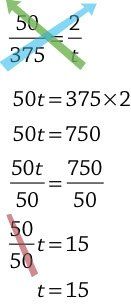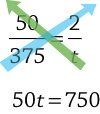The Shortcomings of Cross-Multiplication
A common technique for word problems involving proportional relationships is to “set up proportions and cross-multiply.” This method is useful only in a narrow range of problems, however, so it is not a good foundation for understanding proportional relationships more generally. This “tune-up” explores this method and its limitations.
In school mathematics, some proportion problems present three numbers and ask students to find the missing value. A common technique is to represent the unknown by some symbol, equate two ratios in a “proportion,” and cross-multiply to solve for the unknown.
For example:
- A dragonfly travels 50 feet in 2 seconds. At this speed, how long would it take for the dragonfly to travel 375 feet?
Let’s apply this method. We’ll represent the unknown time by a symbol, “t,” and equate two ratios in a proportion.
We could have used a different but equivalent proportion:
We can cross-multiply either of these equations in order to solve for t.
What’s Good about Cross-Multiplying
We are about to tell you what’s wrong with this technique, but first we have to acknowledge what’s right: in order to set up the proportions, students have to think about which numbers in the problem correspond to which other numbers, and identify the unknown.
Understanding the correspondence is important, and no mean feat. You will often hear experienced students saying, for example, “50 feet is to 2 seconds as 375 feet is to t.” These students recognize that there are two situations, each with two numbers related to each other the same way—and you have to keep them straight. The way they talk about the proportions is evidence of that understanding.
What’s Bad about Cross-Multiplying
Cross-multiplication can lead to trouble. Some students are so thrilled with cross-multiplying that they do it even when the quantities are not proportional. More insidiously, though, although the technique is good for finding answers to specific questions, it's not a lot of help for understanding an overall pattern or the underlying relationships.
To understand these relationships, students need problems and techniques that help them truly understand proportion, look for meaning in mathematical expressions, and connect symbolic math with other representations such as graphs and tables.
Implications for Teaching
What should we do instead? If we want students to generalize, let’s use the epitome of generalization: algebra. Why not take a little extra trouble and teach the algebra in the first place? Why hide it?
Let’s use the dragonfly question as an example, and see what we mean by generalization. Our initial question asked how long it would take a dragonfly to fly 375 feet. Next, we might ask how long it takes to fly 500 feet, or 10 feet, or some other number. We would solve each of these problems the same way—setting up a proportion and cross-multiplying. And every time we would perform the same calculations, just with different numbers.
An algebraic approach would be to make a new variable for that changing distance. Let’s call it “d.”
Then our proportion would be
We want to know t, so we isolate it:
Now we can solve any dragonfly-time problem instantly: we simply divide the distance in feet by 25 to get the number of seconds. By setting up the proportion once, using a new variable, we’ve set things up so we never have to cross-multiply again.
Let’s take a moment to study the expression. The letters represent time and distance. But what does 25 mean in the context of the problem? Students can come to understand that, in this case, it’s how far the dragonfly goes in one second; 25 feet per second is its speed. If instead we asked what 1/25 means, that’s how many seconds it takes to go one foot. (“25” or “1/25” is a parameter. See this tune-up about Variables, Parameters, and Unknowns.)
Looking for meaning in a problem’s numbers is a good habit of mind. Consider, though, when we cross-multiplied, we had this step:
That number, 750, has no easy meaning in the context. Even the units (“feet-seconds”) are hard to understand.
Our general formula for dragonfly time (t = (1/25) d) can help us solve other problems more easily. Suppose we get a different dragonfly question, such as “How far can it fly in a minute?” We don’t have to go back to the proportion; we can multiply both sides by 25 to solve for distance:
Ah: to get the distance in a minute, we multiply 25 by 60 to get 1500 feet. Notice that this formula is in the same form as the familiar, “distance equals rate times time.” As before, we can now use this formula to solve any dragonfly distance problem.
Formulas with two variables succinctly describe a relationship between the two quantities. Either dragonfly formula relates distance to time. Just looking at the equations, we see that the two quantities are proportional to one another: to get one from the other, you multiply by a constant. You can’t see that easily if you only cross-multiply.
The Big Idea
Whatever method students use to solve a particular problem, teachers need to be aware that any solution to a problem of this type depends on the existence of a proportional relationship. In this case, the proportional relationship is expressed in d = 25t, where 25 (feet per second) is the constant speed or, t = (1/25)d, where 1/25 seconds is the time it takes to fly 1 foot.






